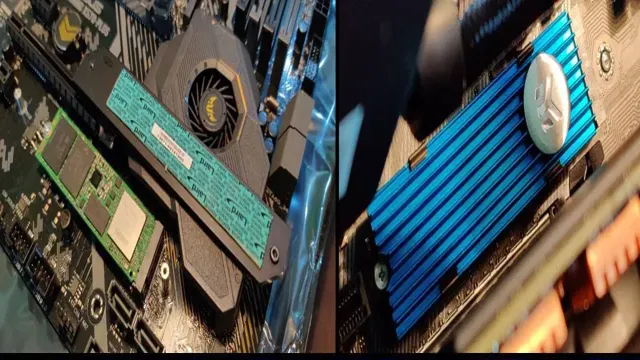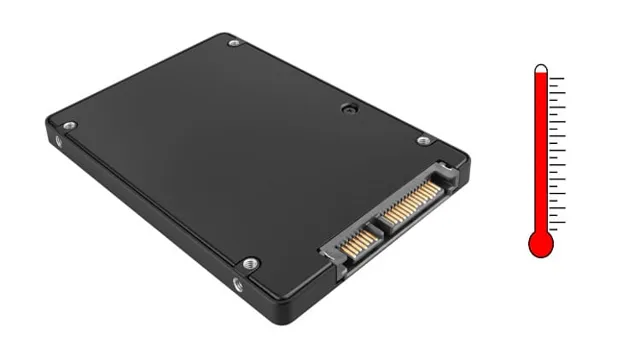As PC enthusiasts, it is essential to keep track of your computer’s temperature, especially when it comes to delicate components such as your solid-state drive (SSD). Overheating can cause permanent damage, resulting in significant loss of data and money. Do you know how to check the temperature of your computer’s SSD? In this blog, we will provide you with detailed steps on how to check SSD temperature and the importance of keeping your SSD cool.
So, let’s dive in and learn how to ensure your SSD stays in tip-top shape!
Why is Monitoring SSD Temperature Important?
If you’re wondering how to check SSD temperature, you’re not alone. Monitoring SSD temperature is important because it can affect the performance and lifespan of your solid-state drive. High temperatures can cause your SSD to slow down or even fail, so it’s essential to keep an eye on it.
Most modern SSDs come with built-in temperature sensors that can be accessed through various software programs such as CrystalDiskInfo or HWMonitor. By regularly checking the temperature of your SSD, you can ensure that it’s running optimally and avoid any potential issues. If you notice that your SSD is running hotter than usual, try improving the airflow in your computer case or upgrading to a better cooling system.
Protect your investment and keep your SSD running smoothly by monitoring its temperature regularly.
Identify potential data loss risk.
As SSDs (Solid State Drives) become increasingly popular due to their fast data access speeds and reliability, it’s important to also consider the potential risks of data loss that come with them. One important aspect to monitor is the temperature of the SSD. An SSD that runs too hot can suffer from data corruption, decreased lifespan, and even complete failure.
This is because high temperatures can cause the electrical components within the drive to degrade. Monitoring the temperature of an SSD can help prevent data loss and extend the drive’s lifespan, which is crucial whether it’s being used for personal or business purposes. By keeping an eye on the temperature and properly cooling the drive, you can ensure that your data remains intact and accessible.
So, if you’re looking to leverage the potential benefits of an SSD, make sure to prioritize temperature monitoring to minimize the risk of data loss and maximize your investment.

Maintain the life and performance of your drive.
When it comes to prolonging the lifespan and maintaining the optimal performance of your SSD, monitoring its temperature is crucial. Your SSD’s temperature can affect its performance and longevity, and a higher temperature can lead to a higher likelihood of data loss or the drive failing altogether. This is because higher temperatures can increase the rate of wear on your drive’s components, especially if they are exposed to those temperatures for an extended period of time.
To prevent this, monitoring your SSD’s temperature and ensuring it stays within safe limits can often mean the difference between a long-lasting, high-performing drive and one that fails prematurely. Make sure to keep an eye on your drive’s temperature to keep it running smoothly and avoid any potential issues down the line.
Methods for Checking SSD Temperature
Wondering how to check the temperature of your SSD? There are a few methods you can use to keep track of your SSD’s temperature and prevent overheating. One way is to use third-party software such as CrystalDiskInfo or HWMonitor. These tools will display real-time information about your SSD’s temperature, among other metrics.
Another option is to check the temperature directly from your computer’s BIOS settings, which usually have a section dedicated to hardware monitoring. Additionally, some SSD manufacturers provide their own software for monitoring drive health and temperature. Keeping your SSD at a safe temperature can help prevent damage and ensure its longevity.
So, don’t hesitate to use one of these methods to ensure your SSD is running at an optimal temperature.
Use SSD monitoring software.
SSD Temperature Checking your SSD temperature is crucial for ensuring its longevity and performance. One way to monitor your SSD’s temperature is to use SSD monitoring software. These utilities can provide real-time data on your drive’s temperature, as well as other important metrics like health and performance.
Programs like CrystalDiskInfo and HWMonitor are great options for Windows users, while DriveDx is a popular choice for Mac users. By regularly checking your SSD temperature and other metrics, you can catch potential issues early and take action before they cause lasting damage to your drive. In short, using SSD monitoring software is an excellent way to stay on top of your drive’s health and ensure its longevity.
BIOS monitoring.
SSD temperature, BIOS monitoring. If you have an SSD in your computer, it’s important to keep an eye on its temperature to avoid overheating and potential damage. One way to do this is through BIOS monitoring.
This involves accessing your computer’s basic input/output system and checking the temperature readings for your SSD. Some motherboards even have specific temperature sensors just for this purpose. Another method for checking SSD temperature is through third-party software.
These programs can provide more detailed information and allow you to set alerts if the temperature rises too high. Whatever method you choose, regularly monitoring your SSD temperature can prolong its lifespan and ensure optimal performance. So don’t forget about this often overlooked aspect of computer maintenance!
Physically check the temperature through the case.
If you want to ensure that your SSD is functioning optimally and doesn’t overheat, you need to check its temperature regularly. One method for doing this is through the case, which involves physically checking the temperature of the SSD by touching it. However, this method isn’t always reliable, as the temperature can vary depending on the location of the SSD, the airflow in the case, and the workload of the system.
Another method is to use specialized software that monitors the temperature of the SSD in real-time. This method is more accurate and less intrusive, and can be set up to alert you if the temperature exceeds a specified threshold. Examples of such software include CrystalDiskInfo, SSD-Z, and HWMonitor.
By monitoring your SSD’s temperature, you can identify any potential issues and take steps to prevent them before they cause damage. So don’t neglect your SSD’s temperature – keep an eye on it and ensure that it stays within safe limits!
Choosing the Right SSD Monitoring Software
Are you looking for ways to check your SSD temperature? Good news! There are several SSD monitoring software programs available that can help. Before choosing the right one for you, it’s essential to consider your needs. If you’re looking for a more straightforward solution, a basic program may suffice.
However, if you require more in-depth information, a more advanced program with robust analytics tools may be necessary. Some popular options include CrystalDiskInfo, HWMonitor, and SSD Health. Additionally, ensuring proper airflow and ventilation around your SSD can help keep it running smoothly and avoid overheating.
Remember, regularly monitoring your SSD’s temperature can help you catch issues before they become major problems, ultimately increasing your system’s lifespan.
Check for compatibility with your SSD brand and model.
When choosing the right SSD monitoring software, it’s essential to consider compatibility with your SSD brand and model. Different SSDs have different needs, and not all monitoring software work with every brand and model. Checking for compatibility is crucial to ensure you get the most out of your SSD and avoid any potential data loss or hardware damage due to incompatible software.
You can usually find this information on the software’s website or by contacting their support team. It’s essential to take this step seriously and not skip it because choosing incompatible monitoring software can result in several issues, including performance inconsistencies and system instability. So, before downloading any software, make sure to check for compatibility with your SSD brand and model.
Look for temperature alerts and notifications.
When it comes to selecting SSD monitoring software, there are several things to keep in mind. Among the most important features to look for is temperature alerts and notifications. This is essential because temperature can have a significant impact on the lifespan and performance of an SSD.
Choosing software that will alert you when your SSD temperature exceeds safe levels can ensure that you take steps to prevent damage or data loss. Another important factor to consider when selecting monitoring software is compatibility with your operating system and SSD type. Make sure that the software you choose is designed for use with your system and can effectively monitor your specific SSD type.
By taking the time to choose the right SSD monitoring software, you can ensure that your valuable data remains safe and your SSD continues to perform at its best.
Final Thoughts
In conclusion, checking the temperature of your SSD is crucial to maintaining its performance and increasing its lifespan. By implementing the various methods discussed earlier, such as using third-party software or accessing the BIOS settings, you can easily monitor your SSD’s temperature and stay ahead of any potential issues. Remember to keep your SSD clean and properly ventilated, and avoid exposing it to excessive heat or moisture.
Finally, it’s always recommended to consult with your SSD manufacturer for specific recommendations and guidelines regarding temperature control. So, if you’re wondering how to check SSD temperature, just follow the steps outlined above, and you’ll ensure optimal performance and longevity for your valuable data storage device.
Conclusion
In conclusion, monitoring the temperature of your SSD is crucial for maintaining its health and performance. Fortunately, it’s a quick and easy process that anyone can do with a few simple steps. Just remember to use a reliable monitoring tool, keep your SSD clean and well-ventilated, and stay vigilant for any warning signs of overheating.
With these tips in mind, you’ll be able to keep your SSD running smoothly and avoid any catastrophic crashes or failures. So, keep your cool and stay on top of your SSD temperature – your computer will thank you for it!”
FAQs
What is the ideal temperature for SSD?
The ideal temperature for an SSD ranges between 0 to 70 degrees Celsius. However, it can operate within a broader spectrum but keeping the temperature within the specified range is recommended.
How can I check the temperature of my SSD?
You can check the temperature of your SSD by using various monitoring software such as HWMonitor, Crystal Disk Info, or SSD Health. These software will provide you with real-time temperature readings of your SSD.
Can high temperatures affect the performance of my SSD?
Yes, high temperatures can affect the performance of your SSD. When the temperature of the SSD increases above the recommended range, it can cause slow data transfer speeds, decreased lifespan, and even failure of the drive.
How can I cool down my SSD?
You can cool down your SSD by using a fan, optimizing your computer’s airflow, or by installing heat sinks. Heat sinks will absorb and dissipate the heat generated by the SSD, which will help reduce its overall temperature.
